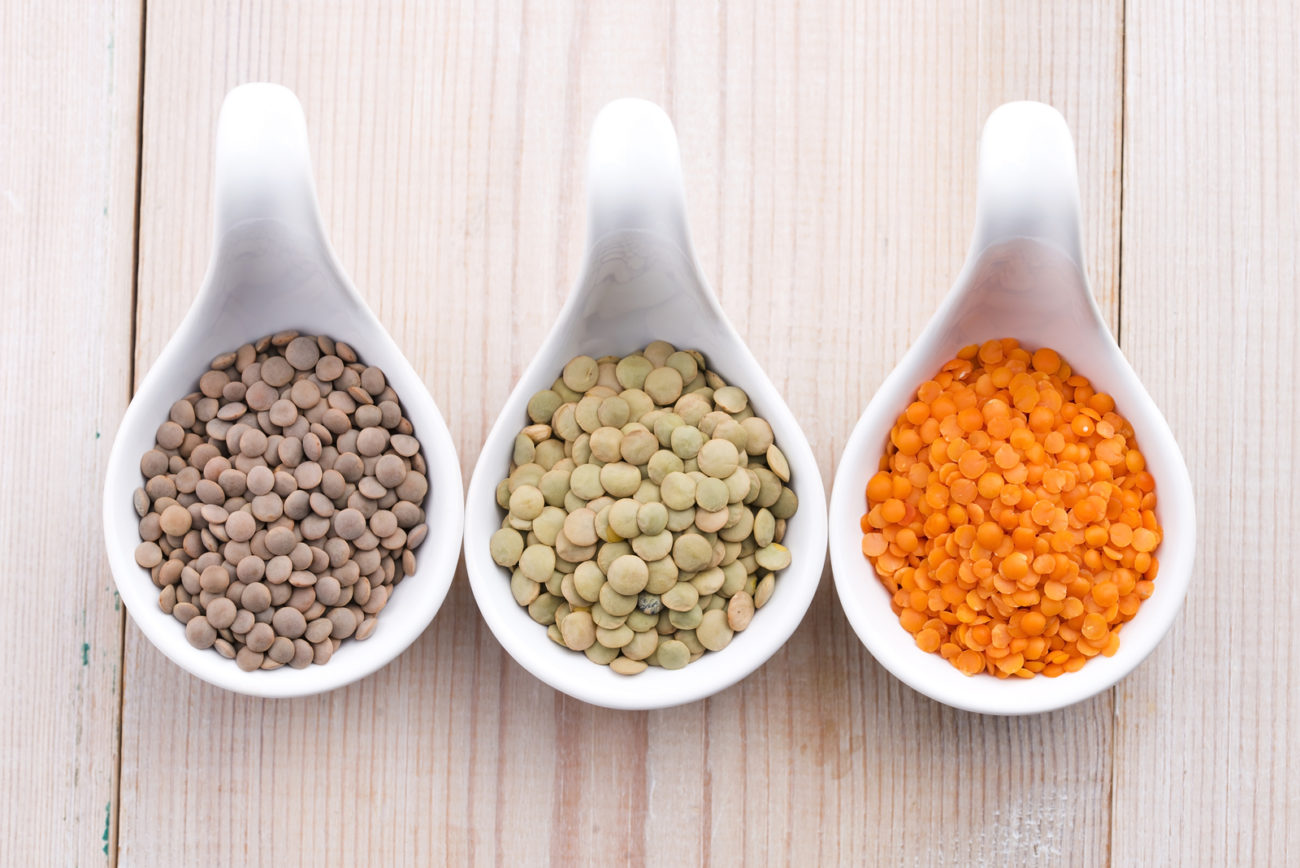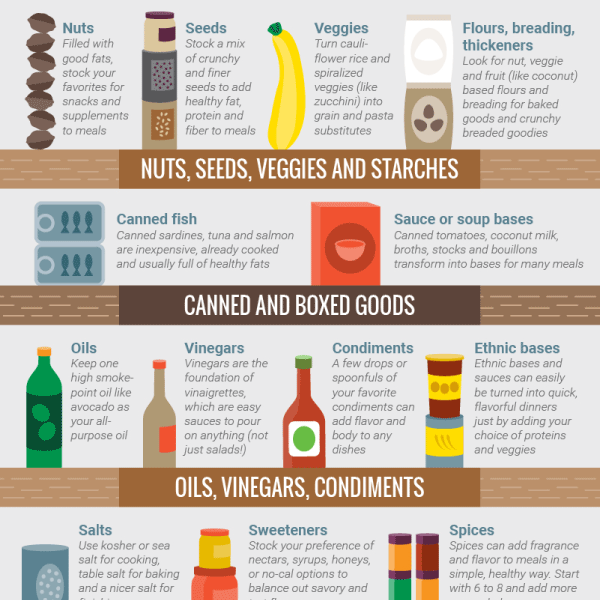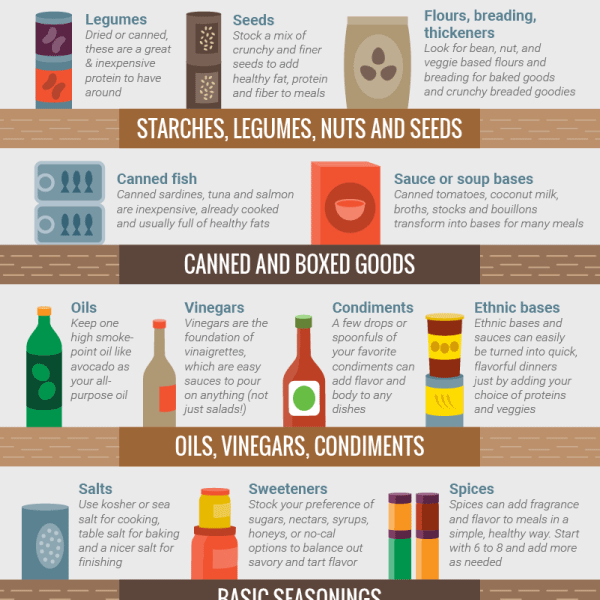Being able to create meals from your pantry is, like any skill, something that will become easier with practice.
Our 63-page comprehensive pantry guide not only tells you what should be in a smartly-stocked pantry, it also gives you plenty of ideas on how to use those pantry essentials. Click below to get this free download delivered right to your inbox, so that you can print it out, stick on your fridge or your wall, and reference at anytime!

Pantry Essentials Guide
Keep your pantry stocked with these basics, so you'll never be far from a simple, healthy meal.
Get Our Pantry Essentials Guide
And make sure you're never far from a home-cooked meal
We know that there are many different diets out there, so to make this a resource that could be for almost everyone, we included gluten-free, paleo, and vegetarian versions, and combined it all into one convenient download.
Paleo Pantry Essentials Guide

Get Our Pantry Essentials Guide
And make sure you're never far from a home-cooked meal
Make paleo cooking simple and tasty with this special paleo guide to pantry essentials.
Vegetarian Pantry Essentials Guide
This vegetarian pantry essentials guide shows all the basics you need to keep vegetarian cooking quick, simple, and delicious.
Get Our Pantry Essentials Guide
And make sure you're never far from a home-cooked meal
Ideas to Put Your Pantry Essentials to Good Use

Your pantry is stocked with all the basics, but what are all the different meals you can create from them? We’re all about cooking formulas, which means that once you learn the method / technique, you won’t need to rely on recipes. Below, we’ll share videos on how to put your stocked pantry to good use!
Grains
When it comes to cooking grains, our biggest tip is to make a larger batch of grains to freeze for easy reheating next time. A super healthy and quick way to make a delicious meal out of any kind of grain – whole or quick-cooking – is to make a grain bowl. You can add whatever pantry items or produce from the fridge you need to use up, or even leftover proteins.
For paleo (and non-paleo!) folks, cauliflower rice has revolutionized healthy eating. It’s a great low-carb alternative, and a delicious way to add more veggies to your meal. You can use cauliflower rice for fried rice, pilafs, and any other way you would enjoy grains.
How to Build a Vegetarian Whole Grain Bowl
See how easy it is to build a tasty, satisfying and healthy vegetarian whole grain bowl!
How to Make Cauliflower Rice
Cauliflower rice is a great low-carb, low-cal alternative to normal rice, and very easy to make.
Pastas & Noodles
When you have nothing else planned, pastas or noodles are the most reliable back-up meal. (Plus it’s comforting and quick!) And if you’re paleo or opting for a low-carb option, try making zucchini noodles, or “zoodles.” Watch our video below on how to make it and try your hand at cooking pasta perfectly . . . just like how the Italians do!
How to Make Vegetable Noodles with a Spiralizer
A spiralizer is a great tool to help you make vegetable noodles, which make a great paleo, gluten-free, or low-carb alternative to traditional pasta.
Tips for Cooking Pasta like Italians
Learn how to make pasta taste flavorful and rich with very little fuss.
Nuts
Nuts are full of good fats and make filling snacks, but they’re also a great supplement to meals like salads, sauteed veggies, and grain bowls. We love using them to bread proteins for a delicious crunch, adding them to homemade trail mixes, and incorporating them into hand-chopped pestos (video below). Nut butters are also great for adding protein to smoothies or making a flavorful sauce for Asian noodles.
How to Make a Hand-Chopped Pesto
Food processors and blenders are not needed to make a delicious herb pesto.
Legumes
Dried or canned, legumes are a healthy, versatile, and inexpensive vegetarian protein to have around. We love using them in soups, enchiladas, burritos, tacos, and salads. They can even be tossed with pasta for added protein, or paired with rice for a classic, budget-friendly meal. And of course, you can’t forget hummus and falafels! Garbanzo beans are the number one ingredient in making these classic Mediterranean dishes. Try making our version of healthy, baked falafels with this video:
How to Make Healthy Baked Falafel
See how simple it is to make our healthy, homemade version of falafel. We used canned beans and the oven to put these together in no time.
Flours, Breading & Thickeners
Flours and breading ensure that baked goods and crunchy breaded goodies can always be readily made. Flours are baking essentials, but they’re also used for cooking to thicken up sauces or to add some body to dishes like pan-fried vegetable fritters (see video below). Cornstarch is essential to stir-fry sauces, thickening the sauce up to coat every piece of protein and veggie. And breadcrumbs are delicious when topped on proteins and baked for a crunchy finish. Watch how the flouring and dredging technique uses these pantry essentials with this video:
How to Make Baked Chicken Cordon Bleu
Baked chicken cordon bleu can be an easy, delicious, and fun-to-make weeknight dinner.
How to Make Broccoli Fritters
Watch this video to learn how to make tasty broccoli fritters. You can change them up by adding any veggies!
Sauces & Soup Bases
Canned tomatoes, coconut milk, broths, stocks, and bouillons transform into bases for many meals. They can be the foundation for sauces, braises, and soups. Adding canned tomatoes and stock to beans, veggies, and spices will give you a flavorful veggie chili. Coconut milk, fish sauce, curry paste, and stock produces a curry soup base that goes well with noodles and proteins.
Watch how we utilize sauces and stocks with two of our most-used cooking formulas – slow cooking meats and making creamy, pureed soups:
How to Slow Cook Meats
Slow cooking meat is a great way to turn tough cuts into tender goodness.
How to Make Pureed Vegetable Soups
See how we turn vegetables into creamy goodness in this short technique video.
Vinegars
Vinegars are the foundation of vinaigrettes, which are easy sauces to pour on anything (not just salads!). We also use them for stir-fry sauces, herb sauces, pickling liquids, and even to balance and enhance flavors in soups and sautes. Watch our videos below to learn how to make homemade vinaigrettes and herb sauces.
If you’re just building your pantry, 2 to 3 varieties of vinegar is a great place to start; we tend to reach for apple cider, balsamic, red wine or sherry, and rice vinegar the most.
How to Make a Vinaigrette
Vinaigrettes are a wonderful way to dress up not just salads, but proteins and vegetables too, and they're very easy to make.
How to Make a Quick Herb Sauce
Learn how to make a quick and easy herb sauce to add flavor to any meal.
Condiments
A few drops or spoonfuls of your favorite condiments can add flavor and body to any dish. Condiments range from all flavor profiles from sweet (ketchup, jams, preserves) to salty / umami (anchovy paste, capers, fish sauce, soy sauce) to spicy (harissa, horseradish, mustard) to sour (creme fraiche, sour cream, yogurt).
Since there are so many different condiments, they can be used all across the board, but here are some of our favorite ideas: mixing mayonnaise and hot sauce together for a flavored “aioli”; whisking in a dollop of yogurt to a veggie soup for an indulgent, creamy soup; and adding fish sauce, hot sauce, and / or soy sauce to Asian soup bases or salads. Our favorite authentic Thai green papaya salad wouldn’t taste the same without fish sauce!
How to Make Thai Green Papaya Salad
This authentic and beloved Thai lunch dish features green, unripe papayas that have a springy texture and tart citrus flavor that are great in salads.
Spices
Spices can add so much fragrance and flavor to meals in a simple, healthy way. They can be added to any kind of dish, even when a recipe doesn’t call for it – roasted veggies, soups, vinaigrettes, marinades . . . really anything!
Start with no more than 6 to 8 spices and experiment with them until you’re ready to branch out more. Our most commonly used spices are black pepper, coriander, cumin, and paprika. Yours may be different! You can also try ethnic spice blends, like Chinese five spice, curry powder, garam masala (Indian), ras al hanout (Moroccan), or za’atar, a Middle Eastern spice blend, which we use in these salmon kebabs:
How to Assemble Salmon Skewers
Thread salmon onto skewers for a fun and tasty way to enjoy kebabs.
Herbs
Dried and fresh herbs can add earthy aroma and another layer of flavor to any dish. 1 to 2 bunches of fresh herbs a week is enough to add a fresh finish to any dish. Dried herbs last longer, so you can keep a variety in your pantry. Our videos below show you two ways to cook with herbs – we add dried Italian seasoning to Pizza-Stuffed Zucchini, and a sprig of fresh thyme to fish en papillote.
To help fresh herbs – like parsley, cilantro and mint – last longer, “plant” them in a jar of water, cover with a plastic bag, seal with a rubber band, and store in the fridge, like how we do here:
How to Store Herbs
Learn how to store herbs so that they'll stay fresher longer and last you for many recipes.
How to Make Pizza-Stuffed Zucchini
This low-carb take on pizza means you can eat more veggies while still enjoying all the flavors of a good pizza.
How to Cook En Papillote
Cooking en papillote is a way to cook fish and chicken in parchment paper - seal the ingredients tightly in parchment and they steam to juicy goodness.
Aromatics
So many meals start with a medley of aromatics – such as garlic, shallots, onions, carrots, and celery – which can add depth and aroma. They’re the start of many soups and can add flavor to vinaigrettes and marinades. Learn how to prep these basic ingredients here:
How to Mince or Crush Garlic
Garlic adds great flavor and aroma to any dish. Learn how to impart the flavors of garlic to any dish with this short video.
How to Chop & Dice an Onion
Learning how to dice an onion correctly will save you so much time in the kitchen.
How to Chop Carrots
Watch this video to learn our tips on how to best peel, chop, and dice carrots easily.
How to Dice Celery
Learn how to chop celery for use in stir-fries, soups, sautes, and salads.
Citrus
Citrus brings out other flavors and adds a brightness to many dishes. We like to keep at least 1 lemon and / or lime in our fridge every week, so we can add a squeeze at the end of cooking to enhance the flavor of a dish. You can use it to make herb sauces or citrus-herb butters, but one crowd-pleaser that makes use of limes is classic guacamole:
How to Make Guacamole
Learn the basics of making guacamole, so you can top on toast, salads, proteins, or enjoy with tortilla chips!
Cheese
Cheeses can be added to an assortment of dishes as a vegetarian protein or just to add some ooey, gooey goodness. Pair cheese with eggs for a breakfast (or brinner) omelet. Top on tomato sauce and proteins and bake for a bubbly, cheesy casserole. And don’t forget grilled cheese, which is basically cheese, bread, and butter. Our new favorite way use cheese when cooking is to stuff in chicken for the ultimate flavor bomb:
How to Make Prosciutto Wrapped Chicken
Chicken stuffed with cheese and wrapped in prosciutto is an easy-to-make gourmet meal that packs a ton of flavor.
Eggs
If you have eggs on hand, you can have a meal in under 5 minutes! They’re a great source of protein and very versatile, so you can create many different dishes with them. Combine eggs with leftover veggies and cheese for a delicious frittata. Use them with flour to make pancakes. Or try mixing eggs with cauliflower rice to make paleo tortillas. There are so many different ways to enjoy eggs, but it’s always best to know these 3 egg-cooking basics – how to fry, poach, and scramble eggs:
How to Fry Eggs
Learn how to fry eggs and enjoy over toast, a salad, a bowl of grains or really anything!
How to Poach Eggs
Poached eggs are such a lovely way to enjoy eggs and they're way easier to make than you think!
How to Scramble Eggs
Learn this basic cooking method of cooking eggs so you can enjoy over toast, a salad, a bowl of grains, or really anything!
Frozen Proteins
Keeping a stock of frozen proteins means you always have something to cook after the simple act of defrosting. These can include meats like chicken, pork, steak, and lamb, as well as vegetarian proteins, such as edamame, tofu, and cooked legumes. Frozen seafood is also good to have in your freezer; we especially like keeping frozen shrimp and fish around because they defrost quickly. Watch how to do it with this video:
Prepping Frozen Shrimp
Watch how we defrost frozen shrimp when we need it for tonight's dinner.
Frozen Veggies
Frozen produce allows you to enjoy your favorite fruits and veggies out of season, and in most cases, they’re just as good as fresh. Plus it can save prepping time and allows you to easily include veggies in every meal. You can use them as you would fresh veggies (though cooking times may vary) – in fried rice, with noodles, and for roasting or sauteing, which we show you how to do here:
How to Roast Veggies
We use super high temperatures to roast veggies quickly, making it perfect for any weeknight dinner.
How to Saute Vegetables
Sauteing is a quick way to prepare and cook a wide variety of vegetables.
This is just the start of all the healthy, tasty meals that you can concoct with items in your pantry. Our download includes many more ideas, as well as suggestions of which items to stock and tips for proper storage. You can get all of that in our complete Pantry Essentials Guide, which is free! Just let us know where to send it, and you’ll be on your way to cooking simple and healthy meals in no time.
Get the download to

